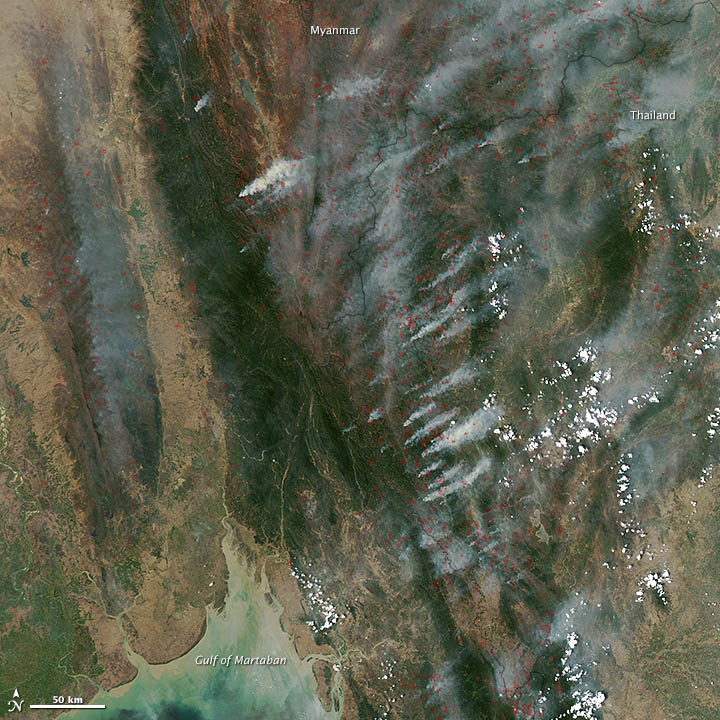
acquired March 22, 2013
download large image (545 KB, JPEG, 1920x1920)
acquired March 22, 2013
download GeoTIFF file (61 MB, TIFF)
acquired March 22, 2013
download Google Earth file (KMZ)
The Asian monsoon dominates the
climate of Southeast Asia. From roughly mid-April to September, it is
rainy and hot; from November to mid-March, it is cooler and dry. Late in
the dry season, fires become widespread (both intentional and
accidental) as people use burning to clear and maintain agricultural and
residential landscapes.
This image of fires burning throughout Burma (Myanmar) and Thailand was acquired on March 22, 2013, by the Moderate Resolution Imaging Spectroradiometer (MODIS) on NASA’s Aqua satellite. MODIS detects fires not from visible smoke plumes, but from thermal infrared energy radiating from the land surface. The heat is invisible in images like this, but the locations where MODIS detected fires are labeled with red dots.
In permanently cultivated (usually lowland) areas, fires are used to burn crop residues and get the land ready for the growing season. In urban and residential areas, people burn leaves, trash, and brush. In the mountains, fires may indicate permanent conversion of forest to agricultural land or they may be associated with shifting cultivation, also known as swidden farming. In this system, patches of forest are cyclically cut down, burned, cultivated, and then left fallow for a time. Secondary forest or other vegetation reclaims the clearing during the fallow period.
Fires have been part of the land management practices for hundreds to thousands of years in this region, and they are not necessarily hazardous...at least not immediately. The smoke from fires has a big influence on air quality and human health, greenhouse gas emissions, the carbon cycle, and biodiversity.
“Temperature inversions that cause significant haze to build up near the surface that far exceed regional air quality standards often occur around this time of year,” explained Ritesh Gautam, a NASA atmospheric scientist. “The amount of smoke in the atmosphere usually peaks in March and April, though it depends somewhat on the timing of the monsoon,”
This image of fires burning throughout Burma (Myanmar) and Thailand was acquired on March 22, 2013, by the Moderate Resolution Imaging Spectroradiometer (MODIS) on NASA’s Aqua satellite. MODIS detects fires not from visible smoke plumes, but from thermal infrared energy radiating from the land surface. The heat is invisible in images like this, but the locations where MODIS detected fires are labeled with red dots.
In permanently cultivated (usually lowland) areas, fires are used to burn crop residues and get the land ready for the growing season. In urban and residential areas, people burn leaves, trash, and brush. In the mountains, fires may indicate permanent conversion of forest to agricultural land or they may be associated with shifting cultivation, also known as swidden farming. In this system, patches of forest are cyclically cut down, burned, cultivated, and then left fallow for a time. Secondary forest or other vegetation reclaims the clearing during the fallow period.
Fires have been part of the land management practices for hundreds to thousands of years in this region, and they are not necessarily hazardous...at least not immediately. The smoke from fires has a big influence on air quality and human health, greenhouse gas emissions, the carbon cycle, and biodiversity.
“Temperature inversions that cause significant haze to build up near the surface that far exceed regional air quality standards often occur around this time of year,” explained Ritesh Gautam, a NASA atmospheric scientist. “The amount of smoke in the atmosphere usually peaks in March and April, though it depends somewhat on the timing of the monsoon,”
References
- Gautam, R. et al (2012, June 14) Characterization of aerosols over the Indochina peninsula from satellite-surface observations during biomass pre-monsoon season. Atmospheric Environment.
- Murdiyarso, D., and Lebel, L. (2007) Local to global perspectives on forest and land fires in Southeast Asia. Mitigation and Adaptation Strategies for Global Change, 12(1), 3-11.
- Padoch, C. et al (2007) The Demise of Swidden in Southeast Asia (pdf)? Danish Journal of Geography, 107(1), 29-41.
NASA image courtesy Jeff Schmaltz, LANCE MODIS Rapid Response. Caption by Adam Voiland and Rebecca Lindsey.
- Instrument:
- Aqua - MODIS
NASA: It is happening now - Está sucediendo ahora - 06-04-13 - Myanmar - Thailand - Fires in Southeast Asia

No hay comentarios:
Publicar un comentario